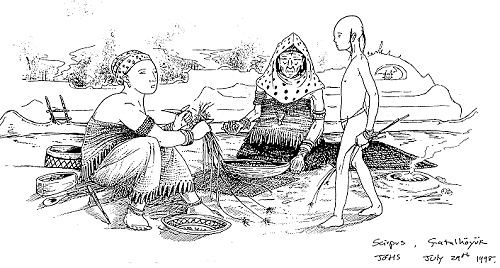Archaeobotanical Analyses
by Christine Hastorf and Julie NearDuring the 1998 field season the archaeobotanical field team focused on four on-site research projects, with two additional collaborative laboratory projects that are ongoing simultaneously off site. The projects are: 1) flotation recovery of botanical remains from every excavation context, 2) ethnobotanical and ethnoarchaeological research in regions surrounding Çatalhöyük, 3) micro-excavation and preliminary analysis of remains from specific contexts, 4) recovery and preliminary analysis of phytoliths from various contexts, 5) wood analysis at the Institute of Archaeology, London, and 6) molecular analysis of archaeological plant material both at METU in Ankara, and at the Research Laboratory for Archaeology, Oxford.
We are particularly interested this year in pursuing new views of diet and food at the site. We are finding evidence for a regular wild plant component, especially the root-rhizome of the marsh growing plant Scirpus. In general, the people seemed to have mainly prepared and eaten soups or toasted grains and nuts, with little evidence for bread and other ground foods. Nuts of wild almond, pistachio, acorn and hackberry, as well as seeds from leafy greens demonstrate a variety of high protein and vitamin-rich wild resources that they consumed daily.

Figure 19: Tentative reconstruction of the processing of Scirpus
Aylan Erkal of the Middle Eastern Technical University focused her masters thesis study on the collection and recording of both environmental and cultural uses of wild taxa including fruits, nuts, tubers, as well as other roots and rhizomes. Dr. Miller Rosen initiated phytolith studies at Çatalhöyük. Analysed samples from the site indicated that large reed grasses such as the common reed (Phragmites sp.) were used as construction material. The silica basketry impressions analyzed came from the Panicoid grasses. This contrasts with the silica skeletons from the matting which were derived from wet-land sedges (Cyperaceae).
Eleni Asouti and Jon Hather of the Institute of Archaeology are studying the charcoal found in the flotation samples. First results revealed a wide variety of woody plants used as firewood by the site's inhabitants. Willows and poplars (Salicaceae), elm (Ulmus), alder (Alnus), ash (Fraxinus), chaste tree (Vitex agnus-castus), tamarisk (Tamarix), cherries (Prunus spp.), various pears and hawthorns (Maloideae), almonds (Amygdalus), wild pistachios (Pistacia), hackberries (Celtis), juniper (Juniperus), oak (Quercus), leguminous shrubs and woody chenopods, are amongst the taxa recovered so far. Some of these were used for other purposes as well, such as construction wood (Juniperus, Quercus) and the manufacture of containers and domestic utensils (e.g., Abies).